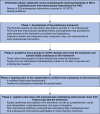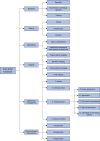Endovascular treatment of peripheral arterial disease: Endo-STAR framework for the design, conduct, and reporting of trials
- PMID: 40241414
- PMCID: PMC12003854
- DOI: 10.1093/bjs/znaf020
Endovascular treatment of peripheral arterial disease: Endo-STAR framework for the design, conduct, and reporting of trials
Erratum in
-
Correction to: Endovascular treatment of peripheral arterial disease: Endo-STAR framework for the design, conduct, and reporting of trials.Br J Surg. 2025 Apr 30;112(5):znaf105. doi: 10.1093/bjs/znaf105. Br J Surg. 2025. PMID: 40332894 Free PMC article. No abstract available.
Abstract
Background: Endovascular technologies continue to evolve to meet the large and growing burden of peripheral arterial disease. The overall quality of published RCTs in endovascular treatments for peripheral arterial disease is low, resulting in uncertainty over treatment effectiveness. The aim of this study was to develop a framework to improve the design, conduct, and reporting of future clinical trials for infrainguinal endovascular treatments of peripheral arterial disease.
Methods: The authors undertook the design, development, and pilot testing of a novel framework. The study comprised four distinct phases. Phase 1 represented the development of a preliminary framework using content analysis of endovascular interventions described in previously published RCTs. Phase 2 consisted of focus groups with key stakeholders to further develop, revise, and achieve initial consensus on the framework. Phase 3 corresponded to the creation of a modified Delphi questionnaire to achieve final consensus on the framework. Phase 4 included cognitive interviews with professionals designing or undertaking endovascular lower limb trials to pilot test the framework.
Results: Content analysis of 228 endovascular interventions from 112 RCTs identified six key themes, relevant to endovascular peripheral arterial disease interventions, for the framework: expertise; setting; anaesthesia; imaging; intervention components (access; crossing lesion; treating lesion (lesion preparation; intervention; intervention optimization; bailout intervention; and treatment of non-target lesions); and closure of artery); and pharmacological interventions. Further refinements were made to the framework as a result of feedback from three focus groups and a Delphi questionnaire. The framework deconstructs an endovascular intervention into its component parts. The final framework can be accessed at www.endo-star.com. Pilot testing evaluated comprehension, clarity, and completeness of interpretation.
Conclusion: The Endo-STAR framework deconstructs endovascular interventions into their key component parts and has been designed and pilot tested to enhance the quality of RCTs of endovascular interventions in peripheral arterial disease. It may be used to assist in developing future trial protocols, the standardization of infrainguinal endovascular interventions, the monitoring of adherence to the trial protocol, and as a standardized reporting guideline.
© The Author(s) 2025. Published by Oxford University Press on behalf of BJS Foundation Ltd.
Figures
References
-
- Eid MA, Mehta K, Barnes JA, Wanken Z, Columbo JA, Stone DH et al. The global burden of peripheral artery disease. J Vasc Surg 2023;77:1119–1126.e1 - PubMed
-
- Song P, Rudan D, Zhu Y, Fowkes FJI, Rahimi K, Fowkes FGR et al. Global, regional, and national prevalence and risk factors for peripheral artery disease in 2015: an updated systematic review and analysis. Lancet Glob Health 2019;7:e1020–e1030 - PubMed
-
- Saeedi P, Petersohn I, Salpea P, Malanda B, Karuranga S, Unwin N et al. Global and regional diabetes prevalence estimates for 2019 and projections for 2030 and 2045: results from the International Diabetes Federation Diabetes Atlas, 9th Edition. Diabetes Res Clin Pract 2019;157:107843. - PubMed
-
- Goodney PP, Beck AW, Nagle J, Welch HG, Zwolak RM. National trends in lower extremity bypass surgery, endovascular interventions, and major amputations. J Vasc Surg 2009;50:54–60 - PubMed



